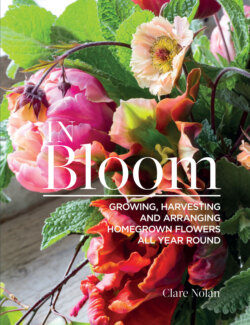Читать книгу In Bloom - Clare Nolan - Страница 34
На сайте Литреса книга снята с продажи.
GETTING THE MOST FROM YOUR PATCH
ОглавлениеSuccessive sowing: Sowing seed in small batches at regular intervals helps to extend your harvest and prevent a glut – there’s no point in having everything ready to pick within four weeks and then nothing for months.
Autumn sowing of hardy annuals: As a gardener, I rarely feel ahead of the game. There’s always something I should have done and a to-do list as long as my arm, because the season seems to fly by. One thing that helps me feel like I’m getting ahead is sowing a batch of hardy annuals such as love-in-a-mist, bishop’s flower, honeywort, and cornflowers in autumn. You’ll get bigger plants than spring-sown ones and earlier blooms – up to four weeks earlier, extending your flowering season even more.
Sow in guttering: I sow seeds in recycled guttering that I’ve cut down to the same width as my rows. It means I’ve always got something waiting in the wings that’s up and running to replace something that is winding down.
FINAL SPACING
When you are growing plants for cut flowers you can afford to plant much more densely than traditional wisdom allows, so ignore the advice on the back of the seed packet. It’s a trick I learnt from flower farmer extraordinaire Erin Benzakein of Floret Flower Farm, and since following her advice on planting spaces I’ve grown so many more flowers in the same plot.
Here’s my planting spaces regime in my 47 in (1 ⅕m) beds:
6 x 6 in (15 × 15cm) – for tall, single-stemmed flowers such as sunflowers and larkspur.
9 x 9 in (24 × 24 cm) – for most annuals: love-in-a-mist, snapdragons, and Icelandic poppies.
12 x 12 in (30 × 30cm) – for bulkier plants such as cosmos, bishop’s flower, foxgloves, and amaranthus.
16 x 16 in (40 × 40cm) – for large plants with a branching habit such as branching sunflowers.
Cornflower seedlings coming up in guttering – I’ll slide these into a spare row in one of my raised beds.
PINCHING OUT
Pinching out the growing tips encourages annuals to bush out and produce more flowering stems. It’s best to do this when the plants are young – when they are 8–12 in (20–30cm) high. Either snap off the growing tip between finger and thumb or else use a pair of flower snips. You want to be taking off about 4 in (10cm), back to just above a set of leaves. Plants that produce only one flower per plant, such as single-stemmed sunflowers or stocks, don’t need to be pinched out.
MAKING THE CUT
When I first started growing my own flowers, I was a little scared when it came to harvesting and made the mistake of cutting too high up the plant – thinking I might do harm if I cut too low. Actually, the opposite is true for most annuals. With annuals that have a central stem, such as zinnias, the first cut early in the season needs to be near the base of the plant – much closer to the ground than you might think, just above three to four sideshoots. This is to encourage a more branching habit and stronger stems. After this first cut, the rest are made toward the end of each stem being cut.
